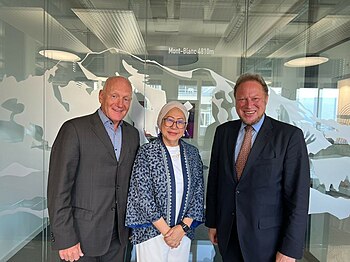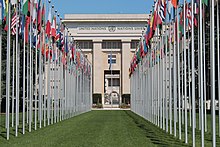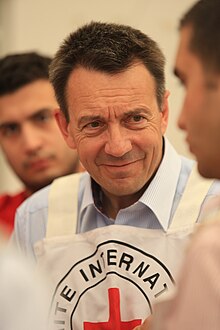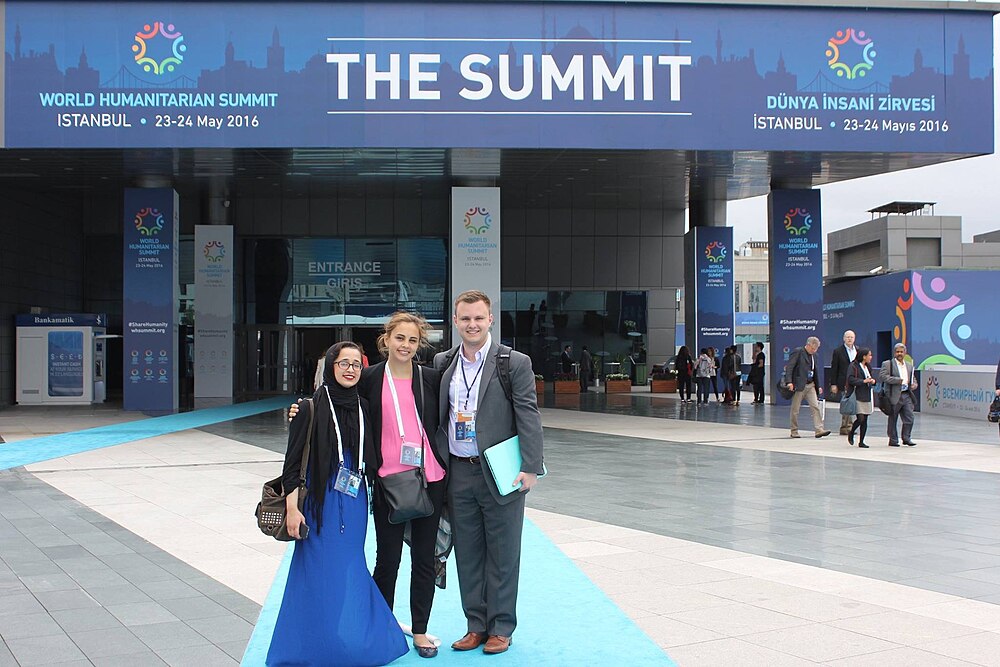The Grand Bargain: Agenda for Humanity, usually called the Grand Bargain, is an agreement to reform the delivery of humanitarian aid, that was struck at the World Humanitarian Summit in May 2016. The agreement contains 51 specific commitments, grouped into ten focus areas, with activity targets to be completed by January 1, 2020.
Parties to the agreement are national governments and humanitarian aid agencies, 30 of which initially signed up, rising to 48 within the first year; the 48 signatories controlled 95% of global humanitarian aid spending at the time. As of 2023, 66 signatories were part of the Grand Bargain process reform, representing an array of humanitarian actors including, 25 members states, 25 NGOs, 12 UN agencies, 2 Red Cross/Red Crescent movements and 2 Inter-governmental organisations.[1]
By 2020, only partial progress had occurred, prompting criticism from some humanitarian practitioners and reflection from others that the original ambitions has an unrealistic time frame.
Five years after the initial agreement of the Grand Bargain in 2016, the Signatories undertook a review in 2021, resulting in the launch of the Grand Bargain 2.0 for two years (until 2023).[2]
In June 2023, the 66 signatories endorsed the new iteration of the Grand Bargain for the 2023-2026 period. Anchored in the original commitments of the agreement, the humanitarian actors focus their efforts on quality funding, localisation, participation of affected populations, the nexus approach, innovative financing, and anticipatory action.[3]
Background

As part of his 2012 goal to improve the humanitarian system, United Nations Secretary-General Ban Ki-moon convened the 2016 World Humanitarian Summit in Istanbul with the goal of knowledge sharing and creating best practices.[4] Ki-moon created the High-Level Panel on Humanitarian Financing, appointing Kristalina Georgieva and Nazrin Shah of Perak, as co-chairs.[5][6]
| Name | Nationality | Affiliation | Role |
|---|---|---|---|
| Kristalina Georgieva | Bulgaria | Vice President for Budget and Human Resources, the European Commission | co-chair |
| Sultan Nazrin Shah | Malaysia | Ruler of Perak, Malaysia | co-chair |
| Hadeel Ibrahim | United Kingdom | Executive Director, Mo Ibrahim Foundation | member |
| Badr Jafar | United Arab Emirates | Managing Director, the Crescent Group | member |
| Walt Macnee | Canada | Vice Chairman, Mastercard | member |
| Trevor Manuel | South Africa | Senior Advisor, Rothschild Group | member |
| Linah Mohohlo | Botswana | Governor, Bank of Botswana | member |
| Dhananjayan Sriskandarajah | Sri Lanka | Secretary-General, CIVICUS | member |
| Margot Wallström | Sweden | Minister for Foreign Affairs | member |
The High-Level Panel on Humanitarian Financing produced the report Too important to fail - addressing the humanitarian financing gap[7] which was presented at the World Humanitarian Summit in May 2016. The report highlighted a US$15 billion shortfall between the cost of addressing humanitarian needs and the global budget to respond. It called for new ways to fund growing humanitarian needs, such as taxation for luxury goods and services.[8][9][5] The group's report called for a Grand Bargain between nations to address the unmet humanitarian needs.[10]
Agreement
Focus areas
Parties to the agreement committed transparently and harmoniously sharing high-quality data on humanitarian funding within two years. The agreement indicated that the International Aid Transparency Initiative data model was likely the best mechanism to record the data. They also commitment to increase spending on local organisations from 0.4% of the overall budget to 25% by 2020. In subsequent years, this effort became known as Localisation. On cash and voucher assistance, conflicting statements were made simultaneously mentioning the benefits of giving people with humanitarian needs cash, but without setting any specific targets, and also calling for more research into benefits and risks. Parties agreed to reduce duplication and management costs; to harmonise the templates for grant agreements between government donors and humanitarian agencies. There was agreement for unification of assessments of unmet humanitarian needs, although that element was criticised by ACAPS for not addressing the necessary changes they called for. A commitment was made to better include the perspectives of the people in communities affected by humanitarian crisis. Parties committed to multi-year funding; to provide aid agencies with agreements to fund their activities for multiple years at a time, rather than requiring annual requests for funding. Parties committed to put more funding into emergency funds, such as the Central Emergency Relief Fund, in order to increase flexibility of how funds can be used in emergencies. Government donors agreed to harmonise the reporting requirements they put on humanitarian agencies by 2018, and reduce the reporting volume. There was agreement to improve collaboration and coordination between groups working on prevention of humanitarian crisis, those working on mitigating the effects of crisis and those responding to emergencies. In total, the Grand Bargain included 51 specific commitments each grouped under the aforementioned themes.
In 2021, a strategic shift was made as the Grand Bargain and its signatories adopted a narrower set of objectives and related adjustments to structures and ways of working to ensure a higher political engagement. This transition was driven both by what had been achieved to date in the various thematic areas of the original Grand Bargain framework from 2016.
As part of the 2023-2026 Grand Bargain iteration,[11] two focus areas have been decided among the Signatories:
• Focus Area 1: Continued support to localisation, participation of affected communities, and quality funding.
• Focus Area 2: Catalysing sector wide transformation through the Grand Bargain.
• Cross-cutting issues
-Gender
-Risk Sharing
Commitments
The Grand Bargain sets out 51 commitments, distilled into 10 thematic workstreams:
• Workstream 1: Greater Transparency
• Workstream 2: More support and funding tools for local and national responders
• Workstream 3: Increase the use and coordination of cash-based programming
• Workstream 4: Reduce duplication and management costs with periodic functional reviews
• Workstream 5: Improve joint and impartial needs assessment
• Workstream 6: Participation Revolution: include people receiving aid in making the decisions which affect their lives
• Workstream 7&8: Increase collaborative humanitarian multi-year planning and funding & reduce earmarking of donor contribution
• Workstream 9: Harmonise and simplify reporting requirements
• Workstream 10: Humanitarian-development nexus
| Topic | Stakeholder(s) | Commitment |
|---|---|---|
| Transparency | Aid agencies and donors | Publishing transparency, timely, open, and harmonized high quality data on funding, within two years of the summit |
| To make use of data that explains the distinctness of aid agencies, and the contexts in which they work | ||
| To improve use of digital tools for accountability, decision making, efficiency, and funding traceability | ||
| To support others with regards to data access and data publishing | ||
| Localisation | Aid agencies and donors | Provide multi-year funding to local and national aid agencies |
| Remove barriers that block partnerships with local and national aid agencies | ||
| To support and collaborate with national governments coordination of humanitarian aid | ||
| To provide 25% of funding to local or national organizations as directly as possible | ||
| To agree, with the Inter Agency Standing Committee, key performance indicator about localisation efforts | ||
| To increase the use of funding tools that enable more funding to local and national aid agencies | ||
| Use of cash | Aid agencies and donors | To increase the use of cash, vouchers and in-kind in humanitarian aid. |
| To fund new aid delivery models that can increase the scale of aid | ||
| To assess the cost and benefits of cash (including for protection) compared to in-kind aid. | ||
| To agree standards and share information about cash programming to better understand the costs and benefits | ||
| To monitor and evaluate cash programming in a coordinated way | ||
| To do more cash programming, where appropriate | ||
| Cost efficiency | Aid agencies and donors | To increase efficiencies of delivery aid with a focus on technology and innovation |
| Harmonize partnership agreements and share information about the needs of people affected by crises | ||
| Aid agencies | To provide transparent and comparable cost structures | |
| To maximize efficiency with regards to procurement of goods and services | ||
| Donors | To reduce individual donors monitoring and evaluations and to make joined assessments | |
| Needs assessment | Aid agencies and donors | To collaborate on one centralised needs assessment for each individual humanitarian emergency |
| To coordinate data collection with a view to reduce intrusion for people affected by crises | ||
| To quickly share needs assessment data, while being mindful of privacy and protection needs | ||
| To fund expert third-party support for data collection to improve collaboration | ||
| To prioritize activities based on evidence. | ||
| To fund independent evaluation of needs assessments | ||
| To undertake risk and vulnerability assessments in collaboration with local authorities and international development agencies | ||
| Participation and inclusion | Aid agencies and donors | Improve national leadership and governance capacity |
| Create common standards for community participation and engagement | ||
| Improve dialogue with local stakeholders | ||
| Create systems to ensure that feedback from local stakeholders is acted upon | ||
| Donors | To be flexible with funding to allow adaptions to local community feedback | |
| To fund and invest time in participation and inclusion | ||
| Aid agencies | To ensure that monitoring and evaluation plans include community feedback by 2017 | |
| Multi-year funding | Aid agencies and donors | To increase funding agreements to cover multiple years, to document efficiency and effectiveness, and to pass on multi-year funding agreements to implementing sub-contractors. |
| To provide multi year funding and associated monitoring and evaluation to at least five national response plans by 2017 | ||
| To improve coordination and collaboration on sharing needs assessments between humanitarian aid and international development stakeholders. | ||
| Reducing the earmarking offunds by nation | Aid agencies and donors | To collectively annually agree the most effective mechanism to report on unearmarked or "softly earmarked" funds by 2017 |
| To increase flexibility of funding, to reduce earmarking funding to certain nations | ||
| Aid agencies | To transparently and regularly share information on how unearmarked funds are spent. | |
| To publicly acknowledge donors who provide flexible funds | ||
| Donors | To reduce national earmarked funds | |
| Reporting | Aid agencies and donors | To harmonize and simplify donor reporting by the end of 2018 |
| To increase use of digital technology in donor reporting | ||
| To improve the efficiency and quality of reporting | ||
| Coordination | Aid agencies and donors | To increase efforts to prevent humanitarian needs |
| To invest in sustainable solutions for people who are forcibly displaced and those returning | ||
| To bolster local systems and to improve local social protection | ||
| To undertake collaborative vulnerability and risk analysis with international development agencies | ||
| To engage better with multilateral development banks. |
In addition to improving the humanitarian system, the commitments were expected to save US$1 billion per year.[13][14]
Each of the ten focus areas has two co-conveners, a government donor and a humanitarian aid agency who report into a facilitation group that coordinates the work between the ten focus areas.[15]
Political leadership
Between 2016 and 2023, the Grand Bargain was championed by an Eminent Person, responsible for promoting and advocating for the advancement of the Grand Bargain commitments.
| Name | Organisation | Period |
|---|---|---|
| Jan Egeland | Norwegian Refugee Council | 2021-2023 |
| Sigrid Kaag | Minister for Foreign Trade and Development Cooperation (Netherlands) | 2019-2021 |
| Kristalina Georgieva | World Bank | 2016-2019 |
The Ambassadors
As of June 2023, the Grand Bargain is championed by three Ambassadors, in 2023-2026: Jemilah Mahmood, Manuel Bessler and Michael Köhler.

Jemilah Mahmood, a humanitarian and medical professional, is currently the Executive Director of the Sunway Centre for Planetary Health at Sunway University in Malaysia. She also advises the Consultative Council for Foreign Policy Malaysia and Ministry of Health Malaysia.[16]Manuel Bessler led humanitarian efforts at Swiss Agency for Development and Cooperation and UN OCHA for over two decades, with roles in New York, Jerusalem, and Pakistan, and worked with UNPROFOR in Yugoslavia in 1994.[17]

Michael Köhler serves as Deputy Director-General for European Civil Protection and Humanitarian Aid Operations at the European Commission, overseeing EU humanitarian aid worldwide. He previously held a number of senior positions in the European Commission, focussing on external relations, neighbourhood, development, energy and maritime policies. Before joining the EU, he worked in the German cooperation ministry BMZ and as a country representative in Morocco and Tunisia for the Konrad-Adenauer-Foundation.[18]
They are responsible for steering the process towards its strategic objective. Each of them leads on specific focus area: participation, localisation, quality funding, and catalysing system-wide transformation.
| Name | Focus Area |
|---|---|
| Jemilah Mahmood | Participation |
| Manuel Bessler | Localisation and quality funding |
| Michael Köhler | Quality funding and catalysing sector wide transformation – anticipatory action, multi-stakeholder collaboration and innovative financing |
Signatories

30 governments and aid agencies signed up to the Grand Bargain initially, expanding to 48 by March 2017.[15] At the time, the 48 signatories controlled 95% of global spending on humanitarian aid.[19] By December 2021, 64 organizations had signed up.[20] Government signatories included USA, UK, Germany, France, and Japan; aid agency signatories included the International Federation of Red Cross and Red Crescent Societies.[14]
Aid agency, Medecins Sans Frontieres, did not sign the agreement, criticizing the process for its non-binding commitments, a decision itself that was criticized as "cynical" by Nancy Lindborg of the United States Institute of Peace.[21]
In 2023, 66 signatories are part of the process.
Critical reception in 2016

In 2016, the Grand Bargain was met with a mixture of enthusiasm, pragmatic caution, and dismay.[13] Lilianne Ploumen pointed out how difficult it is to get multiple governments to all agree to big changes. The Overseas Development Institute criticized the Grand Bargain for its similarity with the status quo, pointing out a need for more specific targets and timelines.[13] Colin Bruce of the World Bank said that the agreement was owned by no-one and stressed the importance of following up on the commitments.[13] Peter Maurer of the International Committee of the Red Cross praised the focus on reducing reporting to donor governments.[13]
Andras Derzsi-Horvath and Julia Steets of the Global Public Policy Institute published an op-ed in DW News criticizing the Grand Bargain for having only voluntary obligations.[22]
Progress towards commitments and critique in the 2020s
In 2021, The New Humanitarian reported that many of the 51 commitments had only been partly met.[23] Wendy Fenton of the Humanitarian Practice Network and Overseas Development Institute said that the 51 commitments were too much to have attempted in five years.[23]
A June 2021 independent review of the Grand Bargain by the Overseas Development Institute praised the progress towards policy shifts around provision of cash assistance, increasing funding to local aid groups, harmonised needs assessments and reporting. It was noted that the policy had a lower impact on actual practice.[24] The Overseas Development Institute review criticised the way the transparency commitments were written, noted the lack of global agreement on how to distribute cash to people in need, and lamented the poor progress towards cost savings. The review reported a lack of political interest in including the perspectives of the people living in humanitarian crises in designing emergency responses.[24]
UK-based group Development Initiatives reported in 2021 that the percentage of funding going to local organisations between 2016 and 2020 actually reduced from 3.5% to 2.1%.[25][26][27] Degan Ali, of Adeso writing in OpenDemocracy in 2020, described the Grand Bargain as a "failed effort".[28]
Since 2016, some progress has been noted on the Annual Independent Reports conducted by the Oversea Development Institute.
Grand Bargain 2.0

In 2021, 60 donors started new negotiations to create an updated Grand Bargain 2.0 that will cover 2020 to 2023.[23] Grand Bargain 2.0 focuses on greater support to local humanitarian agencies, improved participation of people from communities affected by humanitarian crisis and more flexible funding to aid agencies.[23] The June 2021 meeting to agree details was led by Jan Egeland, of the Norwegian Refugee Council.[23]
The Grand Bargain 2.0 agreement attempts to address concerns raised about the original agreement with a focus on an improved consultation process with local organizations.[29]p. 36
Grand Bargain 2023-2026
After a series of consultations and deliberations among the signatories, a consensus has been reached that the Grand Bargain will be extended until at least 2026, which will mark a decade since its initial launch. Following this milestone, a high-level event will be convened to evaluate accomplishments and chart the future course of the agenda.[30]
See also
References
Further reading
External links
- The Grand Bargain Agreement
- Grand Bargain Official website
- Too important to fail—addressing the humanitarian financing gap, 2016, High-Level Panel on Humanitarian Financing
